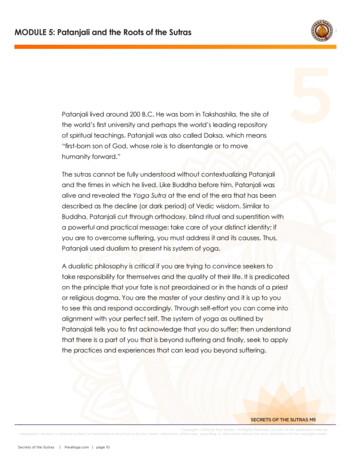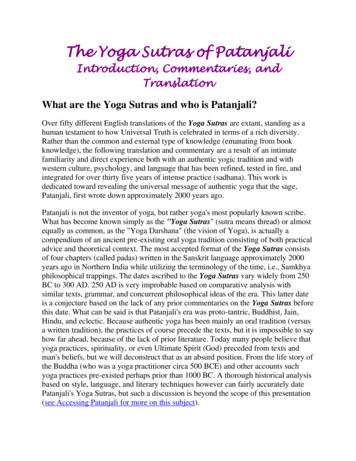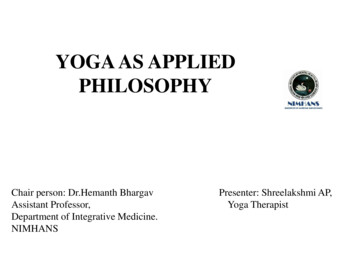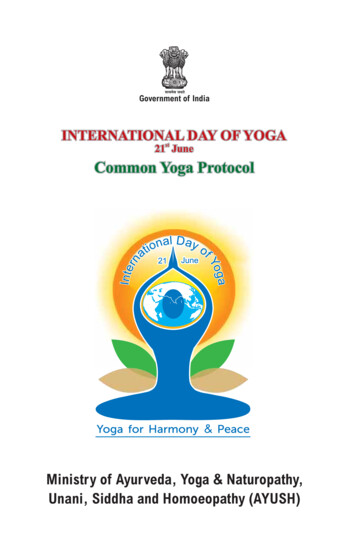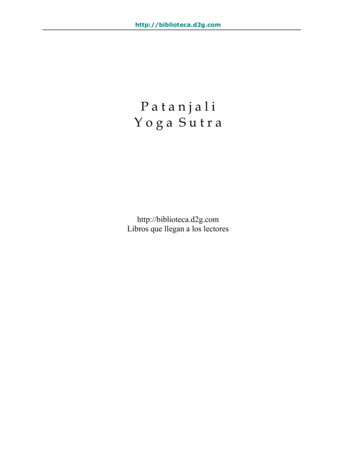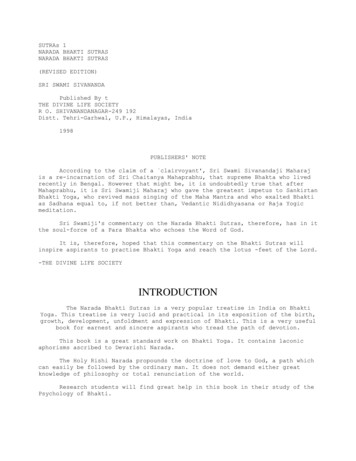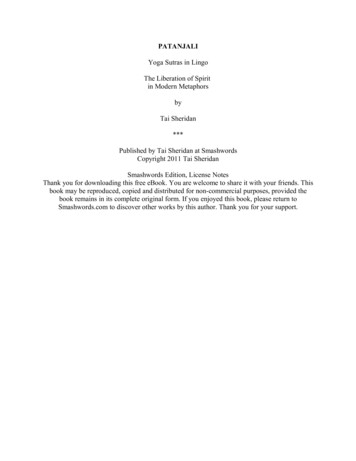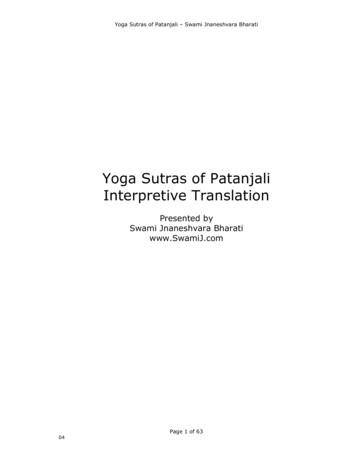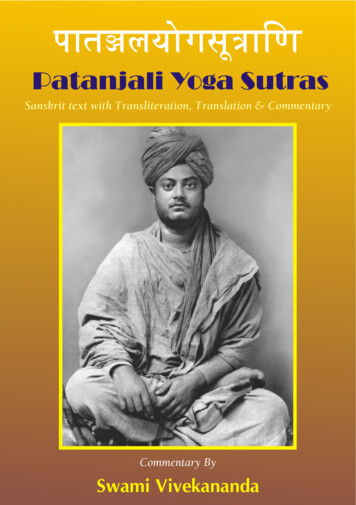
Transcription
The Yoga Sutrasof PatanjaliThe Book of the Spiritual ManAn Interpretation byCharles Johnstonwww.universaltheosophy.com
Introduction to Book IThe Yoga Sutras of Patanjali are in themselves exceedingly brief, less than tenpages of large type in the original. Yet they contain the essence of practicalwisdom, set forth in admirable order and detail. The theme, if the presentinterpreter be right, is the great regeneration, the birth of the spiritual from thepsychical man: the same theme which Paul so wisely and eloquently set forth inwriting to his disciples in Corinth, the theme of all mystics in all lands.We think of ourselves as living a purely physical life, in these material bodies ofours. In reality, we have gone far indeed from pure physical life; for ages, ourlife has been psychical, we have been centerd and immersed in the psychicnature. Some of the schools of India say that the psychic nature is, as it were, alooking-glass, wherein are mirrored the things seen by the physical eyes, andheard by the physical ears. But this is a magic mirror; the images remain, andtake a certain life of their own. Thus within the psychic realm of our life theregrows up an imaged world wherein we dwell; a world of the images of thingsseen and heard, and therefore a world of memories; a world also of hopes anddesires, of fears and regrets. Mental life grows up among these images, built ona measuring and comparing, on the massing of images together into generalideas; on the abstraction of new notions and images from these; till a new worldis built up within, full of desires and hates, ambition, envy, longing,speculation, curiosity, self-will, self-interest.The teaching of the East is, that all these are true powers overlaid by falsedesires; that though in manifestation psychical, they are in essence spiritual;that the psychical man is the veil and prophecy of the spiritual man.The purpose of life, therefore, is the realizing of that prophecy; the unveiling ofthe immortal man; the birth of the spiritual from the psychical, whereby weenter our divine inheritance and come to inhabit Eternity. This is, indeed,salvation, the purpose of all true religion, in all times.Patanjali has in mind the spiritual man, to be born from the psychical. Hispurpose is, to set in order the practical means for the unveiling andregeneration, and to indicate the fruit, the glory and the power, of that newbirth.Through the Sutras of the first book, Patanjali is concerned with the first great1www.universaltheosophy.com
problem, the emergence of the spiritual man from the veils and meshes of thepsychic nature, the moods and vestures of the mental and emotional man. Laterwill come the consideration of the nature and powers of the spiritual man, oncehe stands clear of the psychic veils and trammels, and a view of the realms inwhich these new spiritual powers are to be revealed.At this point may come a word of explanation. I have been asked why I use theword Sutras, for these rules of Patanjali’s system, when the word Aphorism hasbeen connected with them in our minds for a generation. The reason is this: thename Aphorism suggests, to me at least, a pithy sentence of very generalapplication; a piece of proverbial wisdom that may be quoted in a good manysets of circumstance, and which will almost bear on its face the evidence of itstruth. But with a Sutra the case is different. It comes from the same root as theword “sew,” and means, indeed, a thread, suggesting, therefore, a close knit,consecutive chain of argument. Not only has each Sutra a definite place in thesystem, but further, taken out of this place, it will be almost meaningless, andwill by no means be self-evident. So I have thought best to adhere to theoriginal word. The Sutras of Patanjali are as closely knit together, as dependenton each other, as the propositions of Euclid, and can no more be taken out oftheir proper setting.In the second part of the first book, the problem of the emergence of thespiritual man is further dealt with. We are led to the consideration of thebarriers to his emergence, of the overcoming of the barriers, and of certain stepsand stages in the ascent from the ordinary consciousness of practical life, to thefiner, deeper, radiant consciousness of the spiritual man.2www.universaltheosophy.com
Book I1. OM: Here follows Instruction in Union.Union, here as always in the Scriptures of India, means union of theindividual soul with the Oversoul; of the personal consciousness with theDivine Consciousness, whereby the mortal becomes immortal, and entersthe Eternal. Therefore, salvation is, first, freedom from sin and the sorrowwhich comes from sin, and then a divine and eternal well-being, whereinthe soul partakes of the being, the wisdom and glory of God.2. Union, spiritual consciousness, is gained through control of the versatilepsychic nature.The goal is the full consciousness of the spiritual man, illumined by theDivine Light. Nothing except the obdurate resistance of the psychicnature keeps us back from the goal. The psychical powers are spiritualpowers run wild, perverted, drawn from their proper channel. Thereforeour first task is, to regain control of this perverted nature, to chasten,purify and restore the misplaced powers.3. Then the Seer comes to consciousness in his proper nature.Egotism is but the perversion of spiritual being. Ambition is the inversionof spiritual power. Passion is the distortion of love. The mortal is thelimitation of the immortal. When these false images give place to true,then the spiritual man stands forth luminous, as the sun, when the cloudsdisperse.4. Heretofore the Seer has been enmeshed in the activities of the psychicnature.The power and life which are the heritage of the spiritual man have beencaught and enmeshed in psychical activities. Instead of pure being in theDivine, there has been fretful, combative, egotism, its hand against everyman. Instead of the light of pure vision, there have been restless senses andimaginings. Instead of spiritual joy, the undivided joy of pure being, therehas been self-indulgence of body and mind. These are all real forces, butdistorted from their true nature and goal. They must be extricated, likegems from the matrix, like the pith from the reed, steadily, withoutdestructive violence. Spiritual powers are to be drawn forth from thepsychic meshes.3www.universaltheosophy.com
5. The psychic activities are five; they are either subject or not subject to thefive hindrances (Book II, 3).The psychic nature is built up through the image-making power, thepower which lies behind and dwells in mind-pictures. These pictures donot remain quiescent in the mind; they are kinetic, restless, stimulating tonew acts. Thus the mind-image of an indulgence suggests and invites to anew indulgence; the picture of past joy is framed in regrets or hopes. Andthere is the ceaseless play of the desire to know, to penetrate to the essenceof things, to classify. This, too, busies itself ceaselessly with the mindimages. So that we may classify the activities of the psychic nature thus:6. These activities are: Sound intellection, unsound intellection, predication,sleep, memory.We have here a list of mental and emotional powers; of powers thatpicture and observe, and of powers that picture and feel. But the power toknow and feel is spiritual and immortal. What is needed is, not to destroyit, but to raise it from the psychical to the spiritual realm.7. The elements of sound intellection are: direct observation, inductive reason,and trustworthy testimony.Each of these is a spiritual power, thinly veiled. Direct observation is theoutermost form of the Soul’s pure vision. Inductive reason rests on thegreat principles of continuity and correspondence; and these, on thesupreme truth that all life is of the One. Trustworthy testimony, thesharing of one soul in the wisdom of another, rests on the ultimateoneness of all souls.8. Unsound intellection is false understanding, not resting on a perception ofthe true nature of things.When the object is not truly perceived, when the observation is inaccurateand faulty, thought or reasoning based on that mistaken perception is ofnecessity false and unsound.9. Predication is carried on through words or thoughts not resting on an objectperceived.The purpose of this Sutra is, to distinguish between the mental process ofpredication, and observation, induction or testimony. Predication is theattribution of a quality or action to a subject, by adding to it a predicate.In the sentence, “the man is wise,” “the man” is the subject; “is wise” is thepredicate. This may be simply an interplay of thoughts, without the4www.universaltheosophy.com
presence of the object thought of; or the things thought of may beimaginary or unreal; while observation, induction and testimony always goback to an object.10. Sleep is the psychic condition which rests on mind states, all material thingsbeing absent.In waking life, we have two currents of perception; an outer current ofphysical things seen and heard and perceived; an inner current of mindimages and thoughts. The outer current ceases in sleep; the inner currentcontinues, and watching the mind-images float before the field ofconsciousness, we “dream.” Even when there are no dreams, there is still acertain consciousness in sleep, so that, on waking, one says, “I have sleptwell,” or “I have slept badly.”11. Memory is holding to mind-images of things perceived, without modifyingthem.Here, as before, the mental power is explained in terms of mind-images,which are the material of which the psychic world is built, Therefore thesages teach that the world of our perception, which is indeed a world ofmind-images, is but the wraith or shadow of the real and everlastingworld. In this sense, memory is but the psychical inversion of the spiritual,ever-present vision. That which is ever before the spiritual eye of the Seerneeds not to be remembered.12. The control of these psychic activities comes through the right use of thewill, and through ceasing from self-indulgence.If these psychical powers and energies, even such evil things as passion andhate and fear, are but spiritual powers fallen and perverted, how are we tobring about their release and restoration? Two means are presented to us:the awakening of the spiritual will, and the purification of mind andthought.13. The right use of the will is the steady effort to stand in spiritual being.We have thought of ourselves, perhaps, as creatures moving upon thisearth, rather helpless, at the mercy of storm and hunger and our enemies.We are to think of ourselves as immortals, dwelling in the Light,encompassed and sustained by spiritual powers. The steady effort to holdthis thought will awaken dormant and unrealized powers, which willunveil to us the nearness of the Eternal.5www.universaltheosophy.com
14. This becomes a firm resting-place, when followed long, persistently, withearnestness.We must seek spiritual life in conformity with the laws of spiritual life,with earnestness, humility, gentle charity, which is an acknowledgment ofthe One Soul within us all. Only through obedience to that shared Life,through perpetual remembrance of our oneness with all Divine Being, ournothingness apart from Divine Being, can we enter our inheritance.15. Ceasing from self-indulgence is conscious mastery over the thirst forsensuous pleasure here or hereafter.Rightly understood, the desire for sensation is the desire of being, thedistortion of the soul’s eternal life. The lust of sensual stimulus andexcitation rests on the longing to feel one’s life keenly, to gain the sense ofbeing really alive. This sense of true life comes only with the coming of thesoul, and the soul comes only in silence, after self-indulgence has beencourageously and loyally stilled, through reverence before the coming soul.16. The consummation of this is freedom from thirst for any mode of psychicalactivity, through the establishment of the spiritual man.In order to gain a true understanding of this teaching, study must besupplemented by devoted practice, faith by works. The reading of thewords will not avail. There must be a real effort to stand as the Soul, a realceasing from self-indulgence. With this awakening of the spiritual will,and purification, will come at once the growth of the spiritual man andour awakening consciousness as the spiritual man; and this, attained ineven a small degree, will help us notably in our contest. To him that hath,shall be given.17. Meditation with an object follows these stages: first, exterior examining,then interior judicial action, then joy, then realization of individual being.In the practice of meditation, a beginning may be made by fixing theattention upon some external object, such as a sacred image or picture, ora part of a book of devotion. In the second stage, one passes from theouter object to an inner pondering upon its lessons. The third stage is theinspiration, the heightening of the spiritual will, which results from thispondering. The fourth stage is the realization of one’s spiritual being, asenkindled by this meditation.6www.universaltheosophy.com
18. After the exercise of the will has stilled the psychic activities, meditationrests only on the fruit of former meditations.In virtue of continued practice and effort, the need of an external objecton which to rest the meditation is outgrown. An interior state of spiritualconsciousness is reached, which is called “the cloud of things knowable”(Book IV, 29).19. Subjective consciousness arising from a natural cause is possessed by thosewho have laid aside their bodies and been absorbed into subjective nature.Those who have died, entered the paradise between births, are in acondition resembling meditation without an external object. But in thefullness of time, the seeds of desire in them will spring up, and they will beborn again into this world.20. For the others, there is spiritual consciousness, led up to by faith, valourright mindfulness, one-pointedness, perception.It is well to keep in mind these steps on the path to illumination: faith,valour, right mindfulness, one-pointedness, perception. Not one can bedispensed with; all must be won. First faith; and then from faith, valour;from valour, right mindfulness; from right mindfulness, a one-pointedaspiration toward the soul; from this, perception; and finally, full vision asthe soul.21. Spiritual consciousness is nearest to those of keen, intense will.The image used is the swift impetus of the torrent; the kingdom must betaken by force. Firm will comes only through effort; effort is inspired byfaith. The great secret is this: it is not enough to have intuitions; we mustact on them; we must live them.22. The will may be weak, or of middle strength, or intense. Therefore there isa spiritual consciousness higher than this.For those of weak will, there is this counsel: to be faithful in obedience, tolive the life, and thus to strengthen the will to more perfect obedience.The will is not ours, but God’s, and we come into it only throughobedience. As we enter into the spirit of God, we are permitted to sharethe power of God.Higher than the three stages of the way is the goal, the end of the way.7www.universaltheosophy.com
23. Or spiritual consciousness may be gained by ardent service of the Master.If we think of our lives as tasks laid on us by the Master of Life, if we lookon all duties as parts of that Master’s work, entrusted to us, and formingour life-work; then, if we obey, promptly, loyally, sincerely, we shall enterby degrees into the Master’s life and share the Master’s power. Thus weshall be initiated into the spiritual will.24. The Master is the spiritual man, who is free from hindrances, bondage toworks, and the fruition and seed of works.The Soul of the Master, the Lord, is of the same nature as the soul in us;but we still bear the burden of many evils, we are in bondage through ourformer works, we are under the dominance of sorrow. The Soul of theMaster is free from sin and servitude and sorrow.25. In the Master is the perfect seed of Omniscience.The Soul of the Master is in essence one with the Oversoul, and thereforepartaker of the Oversoul’s all-wisdom and all-power. All spiritualattainment rests on this, and is possible because the soul and the Oversoulare One.26. He is the Teacher of all who have gone before, since he is not limited byTime.From the beginning, the Oversoul has been the Teacher of all souls,which, by their entrance into the Oversoul, by realizing their oneness withthe Oversoul, have inherited the kingdom of the Light. For the Oversoulis before Time, and Time, father of all else, is one of His children.27. His word is OM.OM: the symbol of the Three in One, the three worlds in the Soul; thethree times, past, present, future, in Eternity; the three Divine Powers,Creation, Preservation, Transformation, in the one Being; the threeessences, immortality, omniscience, joy, in the one Spirit. This is theWord, the Symbol, of the Master and Lord, the perfected Spiritual Man.28. Let there be soundless repetition of OM and meditation thereon.This has many meanings, in ascending degrees. There is, first, the potencyof the word itself, as of all words. Then there is the manifold significanceof the symbol, as suggested above. Lastly, there is the spiritual realizationof the high essences thus symbolized. Thus we rise step by step to theEternal.8www.universaltheosophy.com
29. Thence come the awakening of interior consciousness, and the removal ofbarriers.Here again faith must be supplemented by works, the life must be led aswell as studied, before the full meaning can be understood. Theawakening of spiritual consciousness can only be understood in measure asit is entered. It can only be entered where the conditions are present:purity of heart, and strong aspiration, and the resolute conquest of eachsin.This, however, may easily be understood: that the recognition of the threeworlds as resting in the Soul leads us to realize ourselves and all life as ofthe Soul; that, as we dwell, not in past, present or future, but in theEternal, we become more at one with the Eternal; that, as we view allorganization, preservation, mutation as the work of the Divine One, weshall come more into harmony with the One, and thus remove the barriersin our path toward the Light.In the second part of the first book, the problem of the emergence of thespiritual man is further dealt with. We are led to the consideration of thebarriers to his emergence, of the overcoming of the barriers, and of certainsteps and stages in the ascent from the ordinary consciousness of practicallife, to the finer, deeper, radiant consciousness of the spiritual man.30. The barriers to interior consciousness, which drive the psychic nature thisway and that, are these: sickness, inertia, doubt, light-mindedness, laziness,intemperance, false notions, inability to reach a stage of meditation, or to holdit when reached.We must remember that we are considering the spiritual man asenwrapped and enmeshed by the psychic nature, the emotional andmental powers; and as unable to come to clear consciousness, unable tostand and see clearly, because of the psychic veils of the personality. Nineof these are enumerated, and they go pretty thoroughly into the brutetoughness of the psychic nature.Sickness is included rather for its effect on the emotions and mind, sincebodily infirmity, such as blindness or deafness, is no insuperable barrier tospiritual life, and may sometimes be a help, as cutting off distractions. Itwill be well for us to ponder over each of these nine activities, thinking ofeach as a psychic state, a barrier to the interior consciousness of thespiritual man.9www.universaltheosophy.com
31. Grieving, despondency, bodily restlessness, the drawing in and sendingforth of the life-breath also contribute to drive the psychic nature to and fro.The first two moods are easily understood. We can well see how a soddenpsychic condition, flagrantly opposed to the pure and positive joy ofspiritual life, would be a barrier. The next, bodily restlessness, is in aspecial way the fault of our day and generation. When it is conquered,mental restlessness will be half conquered, too.The next two terms, concerning the life-breath, offer some difficulty. Thesurface meaning is harsh and irregular breathing; the deeper meaning is alife of harsh and irregular impulses.32. Steady application to a principle is the way to put a stop to these.The will, which, in its pristine state, was full of vigour, has been steadilycorrupted by self-indulgence, the seeking of moods and sensations forsensation’s sake. Hence come all the morbid and sickly moods of themind. The remedy is a return to the pristine state of the will, by vigorous,positive effort; or, as we are here told, by steady application to a principle.The principle to which we should thus steadily apply ourselves should beone arising from the reality of spiritual life; valorous work for the soul, inothers as in ourselves.33. By sympathy with the happy, compassion for the sorrowful, delight in theholy, disregard of the unholy, the psychic nature moves to gracious peace.When we are wrapped up in ourselves, shrouded with the cloak of ouregotism, absorbed in our pains and bitter thoughts, we are not willing todisturb or strain our own sickly mood by giving kindly sympathy to thehappy, thus doubling their joy, or by showing compassion for the sad,thus halving their sorrow. We refuse to find delight in holy things, and letthe mind brood in sad pessimism on unholy things. All these evil psychicmoods must be conquered by strong effort of will. This rending of theveils will reveal to us something of the grace and peace which are of theinterior consciousness of the spiritual man.34. Or peace may be reached by the even sending forth and control of the lifebreath.Here again we may look for a double meaning: first, that even and quietbreathing which is a part of the victory over bodily restlessness; then theeven and quiet tenor of life, without harsh or dissonant impulses, whichbrings stillness to the heart.10www.universaltheosophy.com
35. Faithful, persistent application to any object, if completely attained, willbind the mind to steadiness.We are still considering how to overcome the wavering and perturbationof the psychic nature, which make it quite unfit to transmit the inwardconsciousness and stillness. We are once more told to use the will, and totrain it by steady and persistent work: by “sitting close” to our work, inthe phrase of the original.36. As also will a joyful, radiant spirit.There is no such illusion as gloomy pessimism, and it has been truly saidthat a man’s cheerfulness is the measure of his faith. Gloom, despondency,the pale cast of thought, are very amenable to the will. Sturdy andcourageous effort will bring a clear and valorous mind. But it must alwaysbe remembered that this is not for solace to the personal man, but is ratheran offering to the ideal of spiritual life, a contribution to the universal anduniversally shared treasure in heaven.37. Or the purging of self-indulgence from the psychic nature.We must recognize that the fall of man is a reality, exemplified in our ownpersons. We have quite other sins than the animals, and far moredeleterious; and they have all come through self-indulgence, with whichour psychic natures are soaked through and through. As we climbed downhill for our pleasure, so must we climb up again for our purification andrestoration to our former high estate. The process is painful, perhaps, yetindispensable.38. Or a pondering on the perceptions gained in dreams and dreamless sleep.For the Eastern sages, dreams are, it is true, made up of images of wakinglife, reflections of what the eyes have seen and the ears heard. But dreamsare something more, for the images are in a sense real, objective on theirown plane; and the knowledge that there is another world, even a dreamworld, lightens the tyranny of material life. Much of poetry and art is sucha solace from dreamland. But there is more in dream, for it may imagewhat is above, as well as what is below; not only the children of men, butalso the children by the shore of the immortal sea that brought us hither,may throw their images on this magic mirror: so, too, of the secrets ofdreamless sleep with its pure vision, in even greater degree.11www.universaltheosophy.com
39. Or meditative brooding on what is dearest to the heart.Here is a thought which our own day is beginning to grasp: that love is aform of knowledge; that we truly know any thing or any person, bybecoming one therewith, in love. Thus love has a wisdom that the mindcannot claim, and by this hearty love, this becoming one with what isbeyond our personal borders, we may take a long step toward freedom.Two directions for this may be suggested: the pure love of the artist for hiswork, and the earnest, compassionate search into the hearts of others.40. Thus he masters all, from the atom to the Infinite.Newton was asked how he made his discoveries. By intending my mindon them, he replied. This steady pressure, this becoming one with what weseek to understand, whether it be atom or soul, is the one means to know.When we become a thing, we really know it, not otherwise. Therefore livethe life, to know the doctrine; do the will of the Father, if you wouldknow the Father.41. When the perturbations of the psychic nature have all been stilled, then theconsciousness, like a pure crystal, takes the colour of what it rests on, whetherthat be the perceiver, perceiving, or the thing perceived.This is a fuller expression of the last Sutra, and is so lucid that commentcan hardly add to it. Everything is either perceiver, perceiving, or the thingperceived; or, as we might say, consciousness, force, or matter. The sagetells us that the one key will unlock the secrets of all three, the secrets ofconsciousness, force and matter alike. The thought is, that the cordialsympathy of a gentle heart, intuitively understanding the hearts of others,is really a manifestation of the same power as that penetrating perceptionwhereby one divines the secrets of planetary motions or atomic structure.42. When the consciousness, poised in perceiving, blends together the name,the object dwelt on and the idea, this is perception with exterior consideration.In the first stage of the consideration of an external object, the perceivingmind comes to it, preoccupied by the name and idea conventionallyassociated with that object. For example, in coming to the study of a book,we think of the author, his period, the school to which he belongs. Thesecond stage, set forth in the next Sutra, goes directly to the spiritualmeaning of the book, setting its traditional trappings aside and finding itsapplication to our own experience and problems.The commentator takes a very simple illustration: a cow, where oneconsiders, in the first stage, the name of the cow, the animal itself and the12www.universaltheosophy.com
idea of a cow in the mind. In the second stage, one pushes these trappingsaside and, entering into the inmost being of the cow, shares itsconsciousness, as do some of the artists who paint cows. They get at thevery life of what they study and paint.43. When the object dwells in the mind, clear of memory-pictures, uncolouredby the mind, as a pure luminous idea, this is perception without exterior orconsideration.We are still considering external, visible objects. Such perception as is heredescribed is of the nature of that penetrating vision whereby Newton,intending his mind on things, made his discoveries, or that whereby areally great portrait painter pierces to the soul of him whom he paints, andmakes that soul live on canvas. These stages of perception are described inthis way, to lead the mind up to an understanding of the piercing soulvision of the spiritual man, the immortal.44. The same two steps, when referring to things of finer substance, are said tobe with, or without, judicial action of the mind.We now come to mental or psychical objects: to images in the mind. It isprecisely by comparing, arranging and superposing these mind-images thatwe get our general notions or concepts. This process of analysis andsynthesis, whereby we select certain qualities in a group of mind-images,and then range together those of like quality, is the judicial action of themind spoken of. But when we exercise swift divination upon the mindimages, as does a poet or a man of genius, then we use a power higher thanthe judicial, and one nearer to the keen vision of the spiritual man.45. Subtle substance rises in ascending degrees, to that pure nature which hasno distinguishing mark.As we ascend from outer material things which are permeated byseparateness, and whose chief characteristic is to be separate, just as somany pebbles are separate from each other; as we ascend, first, to mindimages, which overlap and coalesce in both space and time, and then toideas and principles, we finally come to purer essences, drawing evernearer and nearer to unity.Or we may illustrate this principle thus. Our bodily, external selves arequite distinct and separate, in form, name, place, substance; our mentalselves, of finer substance, meet and part, meet and part again, in perpetualconcussion and interchange; our spiritual selves attain true consciousnessthrough unity, where the partition wall between us and the Highest,between us and others, is broken down and we are all made perfect in the13www.universaltheosophy.com
One. The highest riches are possessed by all pure souls, only when united.Thus we rise from separation to true individuality in unity.46. The above are the degrees of limited and conditioned spiritualconsciousness, still containing the seed of separateness.In the four stages of perception above described, the s
Patanjali has in mind the spiritual man, to be born from the psychical. His purpose is, to set in order the practical means for the unveiling and regeneration, and to indicate the fruit, the glory and the power, of that new birth. Through the Sutras of the first book, Patanjali is concerned with the first great 1 ZZZ XQLYHUVDOWKHRVRSK\ FRP
